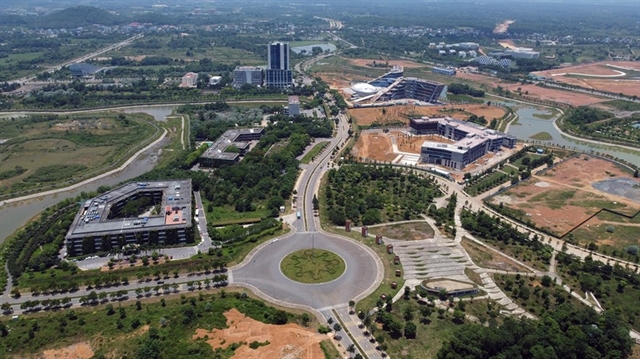 Economy
Economy

 |
| A bird's-eye view of the Hòa Lạc Hi-Tech Park in Hà Nội. VNA/VNS Photo |
HÀ NỘI — According to the Ministry of Planning and Investment (MPI), the Vietnamese government has been working on a plan to build a 50,000-strong workforce for the development of the country's semiconductor industry until 2030, with a vision to 2045.
The ministry said Vietnamese engineers must start engaging in the design of modern semiconductor microchips, participating extensively in the packaging and testing stages and mastering a portion of the packaging and testing technology.
The Southeast Asian economy has set a target to become a crucial link in the global semiconductor industry's value chain with a skilled workforce, meeting the industry's development requirements in terms of both quality and quantity. The National Innovation Center (NIC) has been tasked with leading the drafting of the plan.
Vũ Quốc Huy, director of the NIC, said the plan's key objective is to supply sufficient skilled labour for the domestic semiconductor industry, and potentially export labour to other markets.
Regarding the available semiconductor workforce in Việt Nam, Huy said companies such as VHT (Viettel) and FPT Semiconductor have around 200 employees. Meanwhile, 36 companies from Japan, the United States, Chinese Taipei, China and South Korea have invested in the Southeast Asian economy, employing approximately 5,600 engineers.
Among these, Intel has invested US$1.5 billion in Việt Nam since 2009, employing nearly 3,000 engineers. In the northern province of Bắc Ninh, the Amkor factory has invested over $1.6 billion in three phases.
According to a 2023 report by the MPI, there were sufficient resources in Việt Nam to train about 50,000 engineers for the industry by 2030. Large international corporations are operating in the country including Intel and Amkor in packaging and testing; Marvell, Qorvo and Qualcomm in design; Synopsys and Cadence in providing semiconductor chip design tools.
In addition, there were established cooperation programmes with global semiconductor giants for workforce training. Siemens Group has pledged to support Việt Nam with the most advanced chip design software and hardware, provide training services and collaborate with the NIC to promote the development of the domestic workforce.
Synopsys has supported NIC in establishing a chip design incubation centre at the Hòa Lạc Hi-Tech Park, including advanced Synopsys technologies in modelling and simulation to optimise software and synchronise hardware system-on-chip (SoC) designs. Synopsys also provided training licenses, including curriculum, educational resources, and lecturer training programmes, to help establish the chip design incubation centre.
In an earlier development, the NIC signed a memorandum of understanding with the US semiconductor company Cadence on the implementation of activities to enhance design capabilities and develop semiconductor chip products in Việt Nam. In addition, a specialised training course on microchip design is to be offered to lecturers from universities in the Hà Nội area and engineers in tech companies. — VNS




